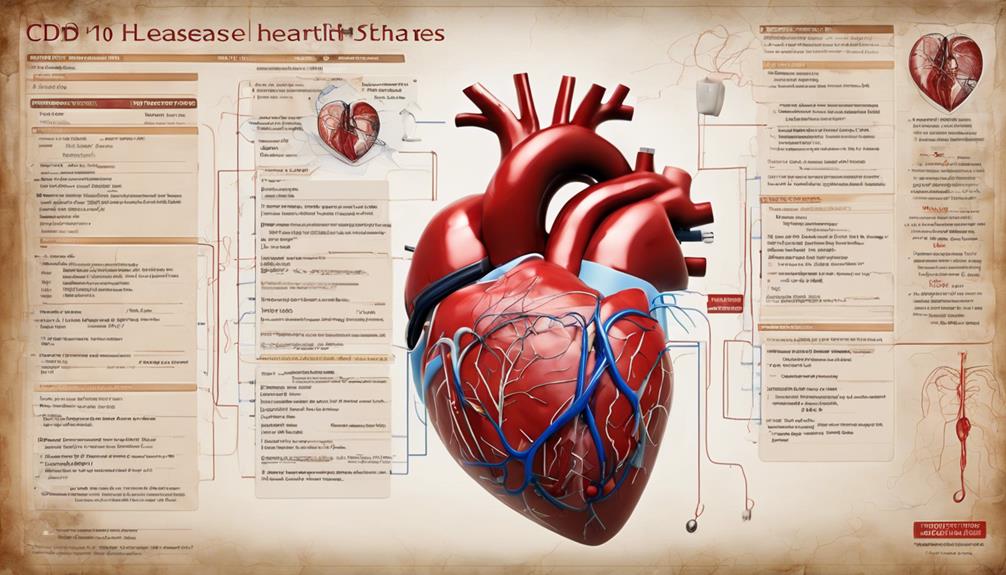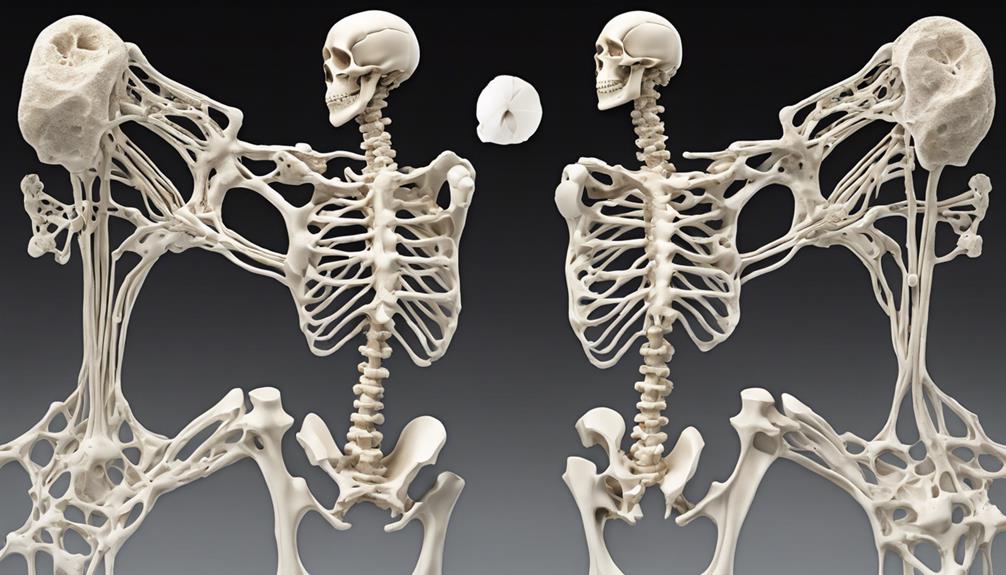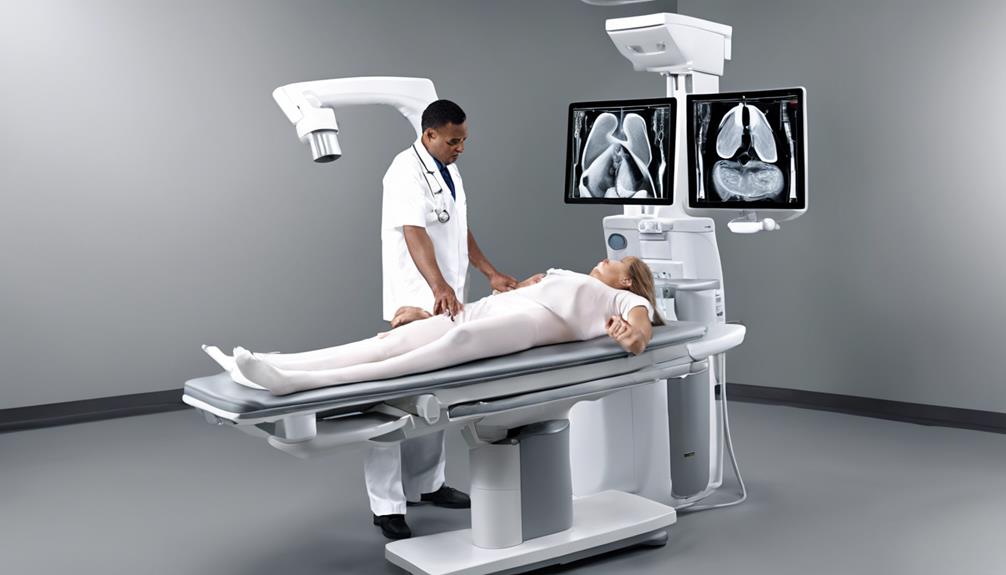When exploring the complex system of ICD-10 codes, one particular code that shines is Z13.820, acting as a beacon for osteoporosis screening. Using this specific code is crucial in identifying individuals who might be at risk for this silent danger.
But what lies beyond this code is a landscape of essential knowledge waiting to be explored. Understanding the nuances of osteoporosis screening and the significance of accurate coding is not just a task; it is a gateway to improved patient care and outcomes.
Key Takeaways
- Z13.820 is vital for accurate osteoporosis screening documentation and billing.
- Accurate diagnosis coding crucial for treatment selection and early detection.
- Proper coding ensures regulatory compliance, financial stability, and effective communication.
- Bone density scans and appropriate ICD-10 coding support osteoporosis diagnosis and treatment.
Understanding ICD-10-CM Codes for Osteoporosis
When screening for osteoporosis, healthcare providers utilize specific ICD-10-CM codes to accurately classify encounters and ensure proper billing procedures. The ICD-10-CM code Z13.820 is designated for 'Encounter for Screening for Osteoporosis' within the Z00-Z99 range, focusing on non-disease or injury circumstances. This code falls under the category of Factors Influencing Health Status and Contact with Health Services, emphasizing prevention and early detection.
It's crucial to note that Z13.820 is exclusively for osteoporosis screening and not intended for other screenings like malignant neoplasms. By employing the correct ICD-10-CM code, such as Z13.820, healthcare providers can streamline documentation processes, enhance patient care coordination, and facilitate accurate reimbursement claims.
Understanding the nuances of these codes is paramount in ensuring that patients receive appropriate preventive care and that healthcare facilities maintain compliance with billing regulations. The utilization of Z13.820 demonstrates a commitment to proactive health management and aligns with the broader goals of promoting wellness within the community.
Importance of Accurate Diagnosis Coding

Accurate diagnosis coding plays a vital role in healthcare, impacting reimbursement, compliance, and research initiatives. Ensuring precision in coding practices not only facilitates proper billing but also supports adherence to regulatory requirements.
The significance of accurate coding can't be overstated in its contribution to patient care quality and the overall efficiency of healthcare systems.
Coding Precision Impacts Reimbursement
Ensuring precise diagnosis coding is paramount for healthcare providers to secure accurate reimbursement for their services rendered. Assigning the correct ICD-10 code, Diagnosis Code, and CPT code is crucial for proper billing and reimbursement.
Coding precision directly impacts the financial stability of healthcare facilities and practices. Accurate coding minimizes the risk of claim denials, payment delays, and potential revenue loss.
Proper Coding Ensures Compliance
Precision in diagnosis coding is fundamental for healthcare providers to maintain compliance with regulations and ensure proper reimbursement for services rendered. When it comes to coding for bone health, accuracy is paramount. Here are three key points to consider:
- Correct Coding: Using the appropriate ICD-10 code for osteoporosis screening (Z13.820) is essential for accurate tracking and management of patients at risk for bone health issues.
- Ensuring Compliance: Adhering to coding guidelines for osteoporosis screening (Z13.820) supports effective communication among healthcare professionals and helps in meeting regulatory requirements.
- Enhanced Patient Care: Accurate diagnosis coding facilitates the delivery of appropriate treatment and preventive measures for patients, ultimately improving outcomes in bone health management.
Accurate Coding Aids Research
Conducting research on osteoporosis screening outcomes greatly benefits from the meticulousness of accurate diagnosis coding. Accurate coding plays a vital role in ensuring data integrity within studies focused on osteoporosis detection.
By employing proper ICD-10 coding for osteoporosis screening, researchers can effectively track and analyze screening trends, leading to more reliable insights. Healthcare providers and researchers rely on precise diagnosis codes to evaluate the efficacy of screening programs.
Consistent and accurate coding practices are essential for supporting evidence-based decision-making in osteoporosis screening initiatives. The reliability of the data collected hinges on the accuracy of the codes used, emphasizing the importance of meticulous coding procedures in advancing research efforts related to osteoporosis screening.
Benefits of Proper Documentation

Proper documentation plays a crucial role in ensuring the accuracy of osteoporosis screening encounters. It not only supports precise billing and coding but also aids in tracking patient history and monitoring osteoporosis risk effectively.
Clear documentation is essential for justifying the necessity of screening services and enhances communication among healthcare providers, ultimately improving patient care.
Importance of Accuracy
Ensuring accurate documentation of osteoporosis screening with ICD-10 codes, such as Z13.820, is crucial for facilitating proper billing and reimbursement processes in healthcare settings. Precision in coding supports early detection and management of bone health issues, aiding in identifying individuals at risk for osteoporosis.
- Targeted Treatment:
Proper documentation enables healthcare providers to choose appropriate interventions based on screening results, ensuring individuals receive the necessary care promptly.
- Efficient Tracking:
Utilizing the correct ICD-10 code Z13.820 promotes efficient tracking and monitoring of bone density over time, allowing for effective follow-up and management.
- Enhanced Patient Care:
Detailed records help in providing personalized care, improving outcomes, and enhancing the overall patient experience.
Legal Compliance Assurance
Transitioning from the importance of accuracy in osteoporosis screening documentation, maintaining precise records not only supports optimal patient care but also ensures legal compliance with healthcare regulations and standards. Proper documentation, such as using the ICD-10-CM Z codes for Encounter for screening, is essential for providing high-quality health services.
Detailed records not only reduce the risk of billing errors and potential audits but also aid in defending against malpractice claims. Compliance with documentation guidelines is crucial for tracking patient outcomes and monitoring the effectiveness of interventions. By adhering to these standards, healthcare providers can uphold the integrity of their practice while delivering comprehensive care to patients.
Improved Patient Care
Improving patient care through meticulous documentation of osteoporosis screening results is crucial for enhancing healthcare outcomes and treatment effectiveness. Proper documentation can significantly benefit patient health by:
- Influencing Health Status: Detailed records aid in assessing the progression of osteoporosis, guiding healthcare providers in making informed decisions to improve patient health.
- Early Detection of Malignant Neoplasms: Accurate documentation allows for the identification of potential secondary health concerns like malignant neoplasms, enabling timely intervention and improved patient outcomes.
- Enhancing Treatment Plans: Comprehensive documentation supports the development of tailored treatment plans, optimizing patient care and promoting overall health and well-being.
Relevance of Z13.820 Code
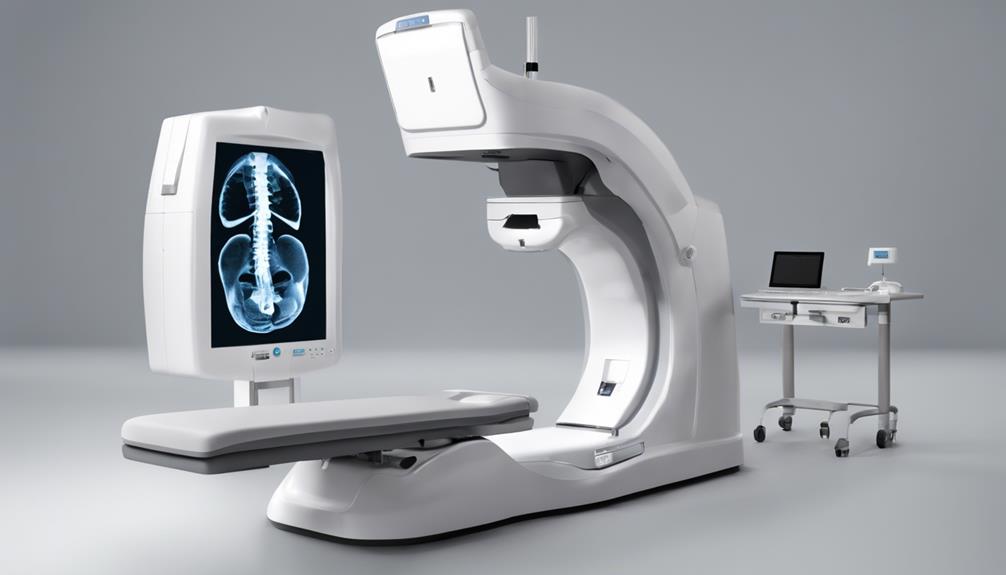
The Z13.820 code plays a crucial role in facilitating accurate billing and reporting for osteoporosis screening encounters. This specific code falls under the category of Factors Influencing Health Status and Contact with Health Services, making it a fundamental tool for healthcare providers.
When documenting encounters related to osteoporosis screening, the Z13.820 code ensures proper reimbursement and compliance with coding guidelines. It's indexed under contact with health services, emphasizing its significance in reflecting the health status of patients undergoing osteoporosis screening.
Moreover, exempt from reporting the Present on Admission (POA) indicator, this code is essential for detailing encounters while being grouped within MS-DRG v41.0 for appropriate billing.
Common ICD-10 Codes for Osteoporosis

As we explore common ICD-10 codes for osteoporosis, it's crucial to understand the significance of accurate diagnosis coding. These codes, such as Z13.820, play a pivotal role in identifying individuals at risk for osteoporosis and ensuring appropriate treatment selection.
ICD-10 Diagnosis Codes
During osteoporosis screening encounters, healthcare providers utilize the ICD-10 code Z13.820 for billing and coding purposes. This code is specifically designed for encounters related to screening for osteoporosis, aiding in accurate documentation and reimbursement.
Here are three key points regarding the use of ICD-10 diagnosis codes for osteoporosis:
- Z13.820 Prevalence**: In 2021, Z13.820 accounted for 14.40% of osteoporosis diagnoses among the top 10 ICD-10 codes.
- Importance of Early Detection: Osteoporosis screening is crucial for early detection and effective management of bone health issues.
- Coding Classification**: Z13.820 falls under the Factors Influencing Health Status and Contact with Health Services category in ICD-10-CM, streamlining the coding process for healthcare providers.
Osteoporosis Screening Guidelines
Utilizing common ICD-10 codes like Z13.820, M81.0, and M81.8 is essential for accurate osteoporosis screening guidelines. These codes help healthcare providers document encounters related to osteoporosis screening effectively.
Screening for osteoporosis typically involves a bone density scan, also known as a DEXA scan, to evaluate bone health. Z13.820 falls under the Factors Influencing Health Status and Contact with Health Services ICD-10 range, specifically for encounter screening for osteoporosis.
Properly assigning ICD-10 codes such as these is crucial for ensuring appropriate reimbursement and tracking of osteoporosis screenings. By adhering to these guidelines and using the correct codes, healthcare professionals can enhance the quality of care provided to individuals undergoing osteoporosis screening.
Coding for Bone Density
Efficient coding with appropriate ICD-10 and CPT codes is crucial for accurately documenting bone density testing for osteoporosis diagnosis and treatment planning.
When coding for bone density, remember the following:
- Use ICD-10 code Z13.820 for osteoporosis screening encounters to identify individuals at risk.
- Utilize common CPT code 77080 for bone density testing to support the diagnosis of osteoporosis.
- Accurate coding ensures proper billing and helps healthcare providers select suitable treatments based on diagnostic results.
Proper documentation supports effective care and management of osteoporosis.
Coding for Musculoskeletal Screenings

Musculoskeletal disorder screenings are accurately coded using the ICD-10 code Z13.8 in healthcare billing processes. Specifically, for screening for osteoporosis, the code Z13.820 is utilized. This code falls under the broader category of Z13.8, which encompasses various musculoskeletal screenings.
Healthcare providers rely on this specific code for precise billing and coding purposes related to musculoskeletal health assessments. It's essential to note that Z13.820 is billable and holds a Present on Admission (POA) exemption status, streamlining the reimbursement process for these screenings.
Coding for Other Specified Diseases
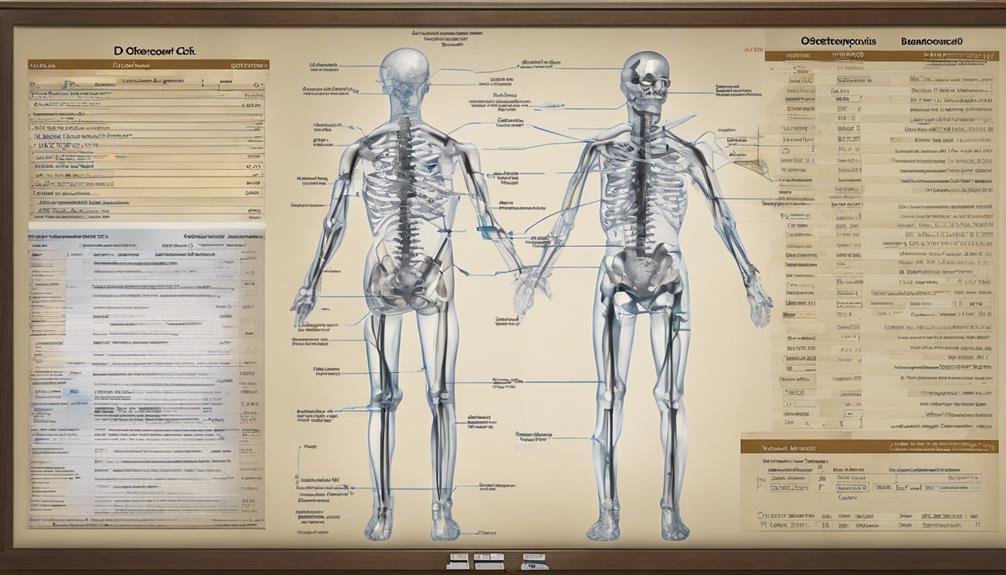
Our focus now shifts to the accurate coding of other specified diseases within the healthcare billing system, ensuring comprehensive documentation for various health assessments and screenings.
- Specific Coding Guidelines: When assigning codes for other specified diseases, it's crucial to follow the specific guidelines provided in the ICD-10-CM manual. These guidelines offer detailed instructions on how to accurately code for conditions that don't have a unique code.
- Documentation Importance: Comprehensive documentation is key when coding for other specified diseases. Healthcare providers need to ensure that all relevant information, including the nature of the disease, diagnostic test results, and any associated symptoms, is clearly documented to support the assigned code.
- Code Selection Accuracy: Selecting the most appropriate code for an unspecified disease is essential for accurate billing and reimbursement. It's important to review the code descriptions and guidelines carefully to determine the best-fitting code based on the patient's specific condition and symptoms.
Unspecified Screening Encounters

Screening encounters for unspecified conditions play a crucial role in preventive healthcare efforts and early detection strategies. When it comes to ICD-10 coding, encounters for unspecified screening can help healthcare providers identify potential health issues before they progress.
While specific diagnosis codes provide detailed information, unspecified codes like Z13.820 allow for a broader approach to screening, covering various conditions under a single code. In the case of osteoporosis screening, using Z13.820 streamlines the coding process and ensures that patients receive the necessary preventive care.
These encounters fall under the Factors influencing health status and contact with health services category, emphasizing the importance of proactive healthcare management. By utilizing unspecified screening encounters, healthcare professionals can efficiently track and monitor patients' health status, leading to early interventions and improved health outcomes.
Top Diagnosed ICD-10 Codes

What were the most frequently diagnosed ICD-10 codes for osteoporosis in 2021 based on the data provided?
Here are the top three ICD-10 codes:
- M810 (Age-related osteoporosis without current pathological fracture): This code was the most diagnosed ICD-10 code for osteoporosis in 2021, indicating a significant prevalence of age-related osteoporosis without current pathological fractures.
- Z13.820 (Encounter for screening for osteoporosis): Despite being the second most diagnosed ICD-10 code, Z13.820 accounted for 14.40% of all osteoporosis diagnoses in 2021, highlighting the importance of screening for this condition.
- Other top ICD-10 codes: The top 10 ICD-10 codes for osteoporosis collectively had an average of 898,013 diagnoses in 2021, with a total of 8,980,128 osteoporosis diagnoses captured by these top codes. This data underscores the widespread impact of osteoporosis and the need for effective screening and management strategies.
Diagnosis Code Analysis

In examining the diagnosis code analysis for osteoporosis, it's crucial to understand the significance of ICD-10-CM code Z13.820 for screening purposes and its implications in healthcare management. This specific code, Z13.820, is designated for encounters related to screening for osteoporosis. It plays a vital role in reimbursement processes and has been effective since October 1, 2023, in the 2024 edition of ICD-10-CM. Falling under the Factors Influencing Health Status and Contact with Health Services category, this code allows healthcare providers to document and track osteoporosis screening accurately.
Worth noting is that screening for osteoporosis is exempt from Present on Admission (POA) reporting requirements. As part of the ICD-10-CM range for 2024, the Z13.820 code caters specifically to screening for osteoporosis, enabling healthcare professionals to manage this aspect of patient care efficiently and effectively.
Osteoporosis Screening Overview

Let's start the discussion on the 'Osteoporosis Screening Overview' by highlighting the importance of screening for this condition.
Osteoporosis screening is crucial for early detection and effective management of the disease.
Understanding the recommended age for screening can aid healthcare providers in offering timely interventions.
Screening Importance
An essential aspect of osteoporosis screening involves utilizing bone density scans like DEXA to evaluate and monitor bone health for early detection of potential issues.
Screening for osteoporosis is essential for several reasons:
- Identifying individuals at risk: Screening helps to identify individuals who are at risk for osteoporosis-related fractures, allowing for proactive management.
- Facilitating timely intervention: Early detection through screening enables timely intervention and treatment, reducing the risk of complications associated with osteoporosis.
- Monitoring bone health: Regular screening allows healthcare providers to monitor changes in bone density over time, guiding personalized treatment plans for better outcomes.
Recommended Age
Engaging in osteoporosis screening at the recommended age marks a crucial step towards proactive bone health management and early intervention. For women, screening is typically advised at age 65 and older, while for men, the recommended age is 70 and older.
However, postmenopausal women under 65 with certain risk factors should also consider screening. Men between 50-69 with specific risk factors should have a discussion with their healthcare provider regarding screening. Additionally, individuals who've experienced fractures after the age of 50 should contemplate undergoing osteoporosis screening.
It's important to note that screening intervals may vary depending on individual risk factors and test results, emphasizing the need for personalized care in osteoporosis management.
Diagnostic Process for Osteoporosis
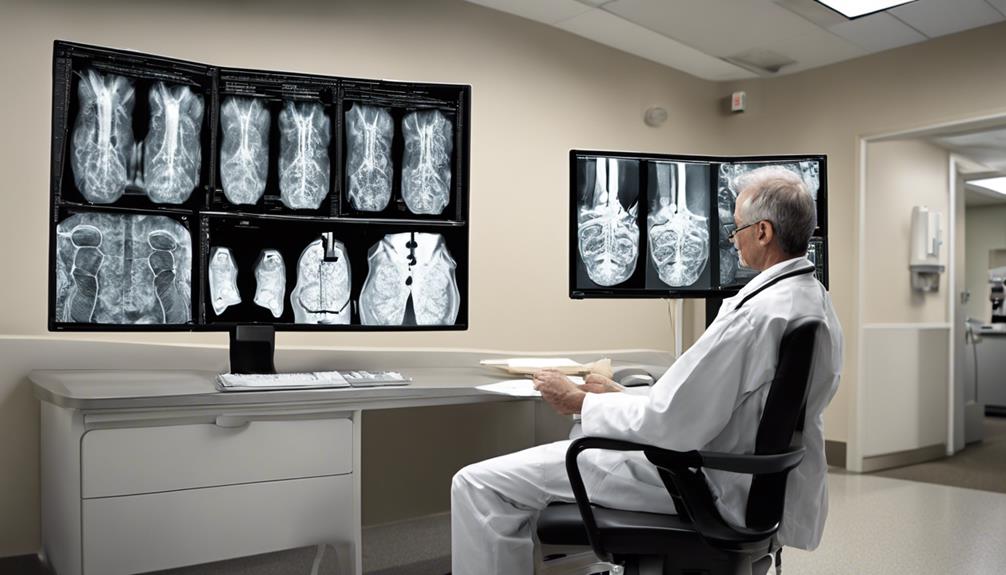
In diagnosing osteoporosis, the primary method utilized is a bone density scan known as a DEXA scan. This non-invasive procedure measures bone mineral density and compares it to the bone density of a healthy young adult, providing a T-score that indicates bone health.
Here are three key aspects of the diagnostic process for osteoporosis:
- Interpreting T-Score: A T-score of -2.5 or lower on a DEXA scan is considered indicative of osteoporosis. This measurement reflects the number of standard deviations below the average bone density of a young adult.
- Assessing Fracture Risk: Beyond bone density, healthcare providers assess other factors like age, gender, medical history, and lifestyle to evaluate the overall risk of fractures and the need for further testing or treatment.
- Monitoring Bone Health: Regular bone density testing helps track changes in bone strength over time, enabling early detection of bone loss and facilitating timely interventions to prevent fractures and manage osteoporosis effectively.
Treatment Options for Osteoporosis

After assessing fracture risk and bone health through diagnostic measures like DEXA scans, individuals diagnosed with osteoporosis can explore various treatment options aimed at strengthening bones and reducing fracture risk.
Medication therapy plays a central role in managing osteoporosis, with options including bisphosphonates, denosumab, teriparatide, and raloxifene. These medications work to increase bone density and reduce the risk of fractures.
Additionally, modifying risk factors such as ensuring adequate calcium and vitamin D intake is crucial in managing osteoporosis effectively. Lifestyle changes, including incorporating weight-bearing exercises like walking or resistance training, and implementing fall prevention strategies, are essential components of osteoporosis treatment.
In severe cases, advanced treatments like biologic medications or hormone therapy may be considered. Regular monitoring and follow-up with healthcare providers are vital to assess treatment effectiveness, make any necessary adjustments, and ensure optimal bone health outcomes.
Impact on Patient Care

Screening for osteoporosis with ICD-10-CM coding significantly impacts patient care by enabling early detection and management of bone density issues. This proactive approach to healthcare ensures that individuals at risk for osteoporosis receive timely interventions, leading to improved outcomes and quality of life. The impact on patient care is profound, with the following key benefits:
- Early Intervention: By identifying individuals with low bone density early on, healthcare providers can initiate appropriate treatments promptly, potentially preventing fractures and other complications associated with osteoporosis.
- Customized Care Plans: Accurate ICD-10-CM coding allows for the development of personalized care plans tailored to each patient's specific needs, ensuring comprehensive management of osteoporosis and associated risk factors.
- Enhanced Follow-Up: With proper coding for osteoporosis screening, healthcare teams can schedule regular follow-up appointments to monitor bone health, adjust treatments as necessary, and provide ongoing support to patients in managing their condition effectively.
Frequently Asked Questions
What Is the ICD-10 Code for Screening for Osteoporosis?
We know the ICD-10 code for screening for osteoporosis is Z13.820. It's essential to use this specific code for encounters related to osteoporosis screening. This code falls under the Factors Influencing Health Status and Contact with Health Services category.
Using Z13.820 ensures accurate medical record keeping and facilitates reimbursement processes. Early detection through osteoporosis screening is crucial for effective management of the condition.
What ICD-10 Code Should I Use for a DEXA Scan?
When using a DEXA scan, the appropriate ICD-10 code to document the procedure is Z13.820. This code is crucial for accurate billing and coding, aiding in the identification of individuals at risk for osteoporosis through bone density testing.
What Is the Age Limit for Z13 820?
We don't have a specific age limit for the Z13.820 code used in osteoporosis screening. This code is versatile and can be applied to individuals of all ages undergoing osteoporosis screening.
It plays a crucial role in identifying and monitoring osteoporosis risk across different age groups. Providers can utilize Z13.820 without age restrictions for their osteoporosis screening encounters, ensuring comprehensive care for patients at varying stages of life.
What Is the ICD-10 Code for Z78.0?
We eagerly share that the ICD-10 code for Z78.0 is notably utilized for osteoporosis screening encounters. This code, falling under Factors Influencing Health Status and Contact with Health Services, is crucial for accurate billing and coding.
Conclusion
In conclusion, accurate coding and documentation are essential in the screening and management of osteoporosis. As the saying goes, 'an ounce of prevention is worth a pound of cure.'
By utilizing the Z13.820 code and other relevant ICD-10 codes, healthcare providers can ensure that individuals at risk for osteoporosis receive timely interventions and appropriate care. This proactive approach can ultimately lead to improved patient outcomes and quality of life.

